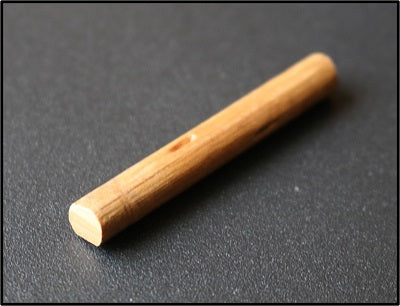Where is the Soundpost on a Violin and what is it for?
Posted by Brittens Team on
Where is the Soundpost on a violin and what is it for?
The Soundpost, sometimes referred to as the Soulpost is simply a small cylindrical wooden dowel (usually made of Spruce), that sits between the top and back plates of the violin.

Whilst a tiny piece of an overall violin, and seemingly an insignificant part, it plays an absolutely vital role in the integrity (strength) and the sound quality of the instrument. Without it, your violin would have limited sound projection and would probably be damaged in a fairly short period of time.
So, where is the soundpost and what does it actually do?
A soundpost is 'wedged' inside a violin between the top and back plates, positioned below and slightly rear of the treble-foot of the bridge (the side with the A and E strings), nearer the tailpiece. It has two significant functions:
i) To transmit the soundwaves from the Top-Plate to the Back-Plateii) To act as a brace between the plates to assist* in adding the strength necessary to support the large down-pressure on the wood created from the strings stretched across the Bridge.
The positioning is extremely important, when setup correctly (by a luthier or experienced technician) it efficiently and 'invisibly' maximises the transmission of the soundwaves from the strings, through the bridge and top-plate down, through the soundpost, to the back-plate. This enables the violin to sound at its best, benefitting from additional volume, projection and tonality that can only be achieved when the instrument harmonises as a whole.
Every violin is unique and as such has an optimal position for its soundpost and even that position may change dependent upon the player's choice of string. Conversely, if the soundpost is not precisely setup and positioned, the violin may still play but will not feel, sound or have the projection it should. If very poorly setup or positioned completely incorrectly, a soundpost can even compromise the structure of a violin, which could put the top and or back-plates at risk of a split or crack, which could be a very expensive repair. So, it is always sensible to ensure you have your violin soundpost setup and positioned by a luthier or trained technician.
Can I play my violin if the soundpost has fallen over?
On violins, soundposts can and do fall over occasionally. Several common factors such as the violin being being knocked over, a poorly fitted soundpost, and / or the instrument being subjected to changes in humidity and temperature can all create conditions where the soundpost may fall over. If your violin soundpost does fall down, do not play the instrument. The integrity is severely compromised without it. Loosen the strings immediately to reduce the pressure from the strings on the top-plate of your violin. Then contact a luthier or string technician to have it re-positioned. A fairly simple task for an expert, not recommended to be attempted by a novice due to the importance of it's role and the potential to damage the instrument.
Can I play my violin without its Soundpost?
You should never play your violin without the Soundpost in place, for all the reasons given above.

** The Bass bar also helps to strengthen the Top-Plate, playing an important role in supporting the down-pressure from the tightened strings.
For more information about the workings and parts of a violin, what they do and what difference they make to the violin's playability and sound, see our post "What are the parts of a violin and what difference does it make?"
